|
For those of you who want to know where I intended to go check out this mpeg of the proposed world wide adventure to the left.
But if you want to know where I ended up - view below.
The original journey plan was to ride around the world. I made it from Australia to the Arctic Circle. To read a brief history of the journey click here |
NORTH AMERICA: Canada - United
States(USA) - Mexico
Click to view all maps and
brief political history |
CENTRAL AMERICA: Belize - Guatemala
- El Salvador - Honduras - Nicaragua - Costa Rica - Panama
Click to view all maps and
brief political history |
SOUTH AMERICA: Colombia - Venezuela -
Brazil - Guyana - Suriname - French Guiana - Peru - Ecuador
- Bolivia - Uruguay - Paraguay - Argentina - Chile
Click to view all maps and
brief political history |
OCEANIA: Easter Island - Tahiti - New
Zealand - Australia
Click
to view all maps and brief political history |

NORTH AMERICA
|

Click map to enlarge |
Canada
- -
- - view
all photos -- view
diary
Map of future trail
DOA - 21st July 2005
Still building |
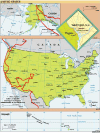
Click map to enlarge
|
United
States (US) - - view
all photos -- view
diary
Map includes current and future
trail.
Still building photo diary section.
|

Click map to enlarge
|
Mexico
- - view
photos - - view
diary |
Return
to top...

CENTRAL AMERICA |
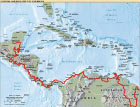
Click maps to enlarge |
Central America -
- view all photos
-- view
diary
I arrived here by
74ft yacht from Cartagena, Columbia. Now foraging around in
Panama tying up loose ends and building a database of information
to assist with the future months of exploration. If anyone has
any recommendations of worthy caves, abandoned dirt roads, shark
feeding bays, base jumping opportunities, or anything that may
increase my heart beat but not quite kill me in the process
I would appreciate. Email me here |
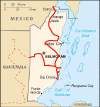 |
Belize - -
view
photos - - view
diary |
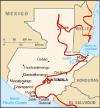 |
Guatemala -
- view
photos - - view
diary |
 |
El Salvador - - view
photos - - view
diary |
 |
Honduras -
- view
photos - - view
diary |
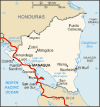 |
Nicaragua -
- view
photos - - view
diary |
 |
Costa Rica -
- view
photos - - view
diary
Costa Rica is a Central American success story: since the late
19th century, only two brief periods of violence have marred
its democratic development. Although still a largely agricultural
country, it has expanded its economy to include strong technology
and tourism sectors. The standard of living is relatively high.
Land ownership is widespread.
coastal plains separated by rugged mountains including over
100 volcanic cones, of which several are major volcanoes
Costa Rica's basically stable economy depends on tourism, agriculture,
and electronic exports.
The most gringo riddled country I have had the pleasure of visiting
thus far. |
 |
Panama - -
view
photos - - view
diary
In 1903 Panama signed
a treaty with the US allowing for the construction of a canal
and US sovereignty over a strip of land on either side of the
structure (the Panama Canal Zone). The Panama Canal was built
by the US Army Engineers between 1904 and 1914. On 7 September
1977, an agreement was signed for complete transfer of the Canal
from the US to Panama by the end of 1999. The entire Panama
Canal, the area supporting the Canal, and remaining US military
bases were turned over to Panama by December 1999. More information
later... |
Return
to top...

SOUTH AMERICA
|

Click maps to enlarge |
South America -
- view all photos
- - view
diary
15months, over 70,000
land and sea kilometres (more than 7,000kms on over 50 boats),
crossing thousands of rivers, passing 15 countries, bouncing
over the Andes, cruising the Caribbean, rolling around the Bays
of Rio De Janeiro, penetrating the southern most point in the
world Cape Horn, passing wild pumas in the forests of Guyana,
floating from the Ecuadorian Andes to the mouth of the Amazon
with my bike in tow, performing two engine rebuilds in Bolivia
and Venezuela and other such things... I have almost killed
my bike. It cries every day. But it still moves, so theres a
positive for you. |
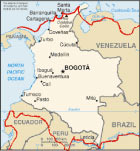 |
Columbia -
- view
photos - - view
diary
Colombia was one of the three countries
that emerged from the collapse of Gran Colombia in 1830 (the
others being Ecuador and Venezuela). A 40-year insurgent campaign
to overthrow the Colombian Government escalated during the 1990s,
undergirded in part by funds from the drug trade. Although the
violence is deadly and large swaths of the countryside are under
guerrilla influence, the movement lacks the military strength
or popular support necessary to overthrow the government.
Colombia's economy suffers from
weak domestic and foreign demand, austere government budgets,
and serious internal armed conflict, but seems poised for recovery.
I love Colombia. They are some of the most sincere, helpful
and considerate people I have ever met. Phenomenal natural scenery,
cheap travel, fantastic historical architecture and a positive
environment. At heart these people are lovers of life, not fighters
of war. They just do what they have to do to survive. If you
visit South America Colombia should definately be included in
your adventure. |
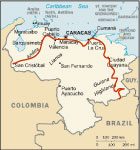 |
Venezuela
- - view
photos - - view
diary
In the early 20th century, Venezuela
was ruled by military strongmen, who promoted the oil industry
and allowed for some social reforms. Democratically elected
governments have held sway since 1959. Current concerns include:
a polarized political environment, a divided military, drug-related
conflicts along the Colombian border, increasing internal drug
consumption, overdependence on the petroleum industry with its
price fluctuations, and irresponsible mining operations that
are endangering the rain forest and indigenous peoples. Images
of Chavez their president, ponder your future from most walls.
Venezuela is highly dependent on the petroleum sector, which
accounts for roughly one-third of GDP, around 80% of export
earnings, and more than half of government operating revenues.
It is a modern and expanding country with a huge tract of the
Amazon rising up from the south. Great place, just try to avoid
the touristy parts. From what I saw beer is more popular than
water. |
 |
Guyana
- - view
photos - - view
diary
Originally a Dutch colony in
the 17th century, by 1815 Guyana had become a British possession.
The abolition of slavery led to black settlement of urban
areas and the importation of indentured servants from India
to work the sugar plantations. Guyana achieved independence
from the UK in 1966, but until the early 1990s it was ruled
mostly by socialist-oriented governments. In 1992, Cheddi
JAGAN was elected president, in what is considered the country's
first free and fair election since independence. The local
people speak English, Amerindian dialects, Creole, Hindi and
Urdu. Over 30% of the population is Hindu.
I have never met so many Rastafaris
in my life. Favourite pickup line.. You got sumwun ta share
dat pineapple witd? First place I have ever seen a Puma in
its natural environs. Mind boggling virgin rainforest and
reggae music. |
 |
Suriname
- - view
photos - - view
diary
Independence from
the Netherlands was granted in 1975. Five years later the civilian
government was replaced by a military regime that soon declared
a socialist republic. In 1989, the military overthrew the civilian
government, but a democratically-elected government returned
to power in 1991.
Growing
transhipment point for South American drugs destined for Europe
and Brazil; transshipment point for arms-for-drugs dealing.
Christmas was spent in the capital, Paramaribo, relaxing in
a small white single windowed room with Hayley, a green plastic
Christmas tree, silver tinsle and various newspaper wrapped
presents out the back of a small Javanese
restuarant near the town centre. |
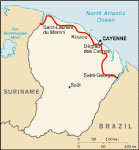 |
French
Guiana - -
view photos - - view
diary
First settled by the French in 1604, French Guiana was the
site of notorious penal settlements until 1951. The European
Space Agency launches its communication satellites from Kourou.
A well-known survivor of its cells Papillon, wrote an awesome
book about life on the inside. I read it once, then it slid
through four different brains. I read it once more and have
since discarded the book pages at a time throughout various
parts of the Guyana's. I still have 97 pages left.
Over 90% of the land is forest and its population
is 191,309 (2004 est.)
It has 722kms of paved road and 3760kms of
navigatable waterway |
 |
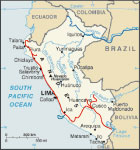 |
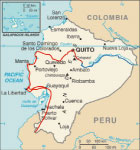 |
Brazil
view
photos - - view
diary
|
Peru
view
photos - - view
diary |
Ecuador
view
photos - - view
diary |
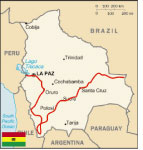 |
 |
 |
Bolivia
view
photos - - view
diary
|
Argentina
view
photos - - view
diary |
Chile
view
photos - - view
diary |
Return to top...

OCEANIA
|
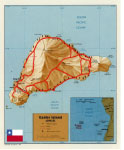 |
 |
 |
Easter Island - Chile
view
photos - - view
diary |
Tahiti - French Polynesia
view
photos - - view
diary |
New Zealand - Sheep Country
view
photos - - view
diary |
Image of Australia...and the rest of the world coming soonish.
Well, the next couple of years anyway. |